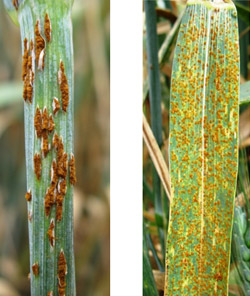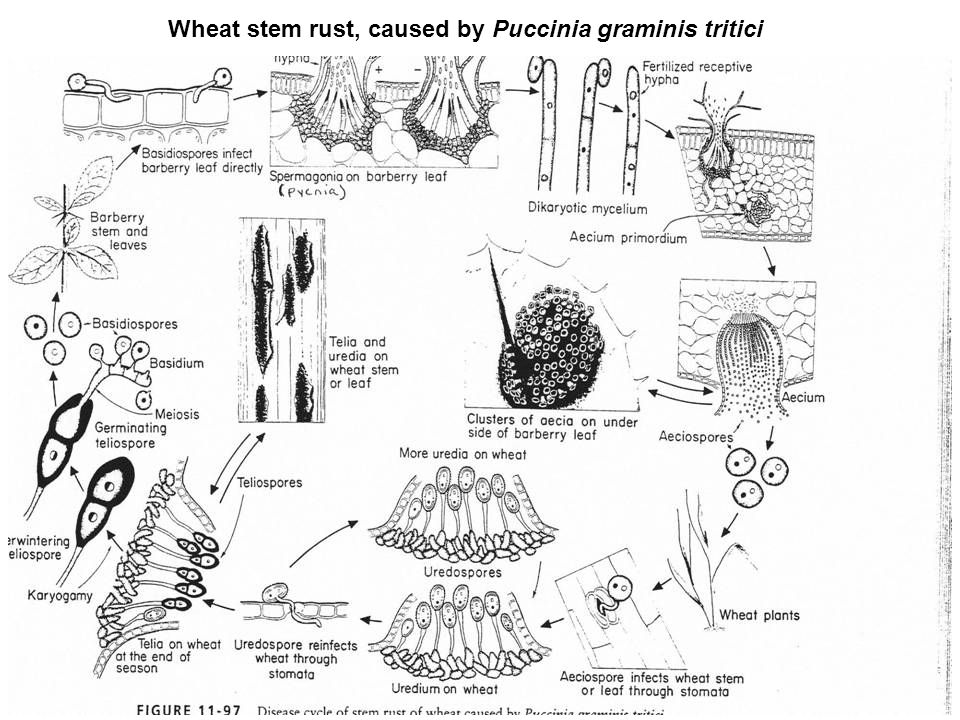Introduction:
Rust diseases of wheat are among the oldest plant diseases known to humans. Early literature on wheat cultivation mentions these devastating diseases and their ability to destroy entire wheat crops. Since rust discovery, numerous studies have been conducted on the life cycles of rust pathogens and their management. The information gained from these studies has enabled us to develop best management practices that reduce the impact of the diseases. Today, worldwide epidemic losses are rare, though the diseases can occur at significant levels in particular fields or throughout a particular growing region. The persistence of rust as a significant disease in wheat can be attributed to specific characteristics of the rust fungi. These characteristics include a capacity to produce a large number of spores—which can be wind-disseminated over long distances and infect wheat under favorable environmental conditions—and the ability to change genetically, thereby producing new races with increased aggressiveness on resistant wheat cultivars.
Symptoms: There are three rust diseases that occur on wheat: stem rust, leaf rust and stripe rust. These diseases are each caused by a particular species of the “rust” fungus, Puccinia. Rust fungi all produce similar disease symptoms on the host plants and have similar requirements for infection. The diseases get their name from their appearance on the plant. Infection can occur on any above-ground plant part, leading to the production of pustules that contain thousands of dry yellow-orange to reddish-brown or black spores. These pustules give the appearance of “rust” on the plant.
There are three rust diseases that occur on wheat: stem rust, leaf rust and stripe rust. These diseases are each caused by a particular species of the “rust” fungus, Puccinia. Rust fungi all produce similar disease symptoms on the host plants and have similar requirements for infection. The diseases get their name from their appearance on the plant. Infection can occur on any above-ground plant part, leading to the production of pustules that contain thousands of dry yellow-orange to reddish-brown or black spores. These pustules give the appearance of “rust” on the plant.
Stem rust occurs primarily on stems but can also be found on leaves, sheaths, glumes, awns, and even seed.
Symptoms begin as oval to elongate lesions that are generally reddish-brownin color. In the late stages of the disease, erumpent pustules produce numerousblack sooty spores. Severe infestations with many stem lesions may weaken plant stems and result in lodging.
Symptoms begin as small circular to oval yellow spots on infected tissue of the upper leaf surface. As the disease progresses, the spots develop into orange-colored pustules that may be surrounded by a yellow halo.
The pustules produce a large number of spores that are easily dislodged from the pustule, resulting in an “orange dust” on the leaf surface or on clothes, hands, and equipment. As the disease progresses, black spores may be produced, resulting in a mixture of orange and black lesions on the same leaf. Tiny orange lesions may be present on seed heads, but these lesions do not develop into erumpent pustules. This difference helps to distinguish leaf rust from stem rust.
Chlorosis, or yellowing, of leaves can be quite evident with both leaf and stripe rust, and fields with plants displaying severe symptoms may be easily detectable from a distance.
 There are three rust diseases that occur on wheat: stem rust, leaf rust and stripe rust. These diseases are each caused by a particular species of the “rust” fungus, Puccinia. Rust fungi all produce similar disease symptoms on the host plants and have similar requirements for infection. The diseases get their name from their appearance on the plant. Infection can occur on any above-ground plant part, leading to the production of pustules that contain thousands of dry yellow-orange to reddish-brown or black spores. These pustules give the appearance of “rust” on the plant.
There are three rust diseases that occur on wheat: stem rust, leaf rust and stripe rust. These diseases are each caused by a particular species of the “rust” fungus, Puccinia. Rust fungi all produce similar disease symptoms on the host plants and have similar requirements for infection. The diseases get their name from their appearance on the plant. Infection can occur on any above-ground plant part, leading to the production of pustules that contain thousands of dry yellow-orange to reddish-brown or black spores. These pustules give the appearance of “rust” on the plant.Stem rust occurs primarily on stems but can also be found on leaves, sheaths, glumes, awns, and even seed.

Symptoms begin as oval to elongate lesions that are generally reddish-brownin color. In the late stages of the disease, erumpent pustules produce numerousblack sooty spores. Severe infestations with many stem lesions may weaken plant stems and result in lodging.
Symptoms begin as small circular to oval yellow spots on infected tissue of the upper leaf surface. As the disease progresses, the spots develop into orange-colored pustules that may be surrounded by a yellow halo.
The pustules produce a large number of spores that are easily dislodged from the pustule, resulting in an “orange dust” on the leaf surface or on clothes, hands, and equipment. As the disease progresses, black spores may be produced, resulting in a mixture of orange and black lesions on the same leaf. Tiny orange lesions may be present on seed heads, but these lesions do not develop into erumpent pustules. This difference helps to distinguish leaf rust from stem rust.

Chlorosis, or yellowing, of leaves can be quite evident with both leaf and stripe rust, and fields with plants displaying severe symptoms may be easily detectable from a distance.
Causal Organisms:Stem rust (also known as black stem rust) is caused by Puccinia graminis f. sp. tritici.It is primarily a disease on wheat, though it can also cause minor infections on certain cultivars of barley and rye. Leaf rust is caused by Puccinia recondita f. sp. tritici(now known as Puccinia triticina). Like the stem rust fungus, this pathogen is primarily a problem on wheat, but it may be weakly pathogenic on some cultivars of barley, triticale, and some species of goatgrass and wheatgrass.
Life Cycle:
Rust fungi have complex life cycles, which may require two specifically different host plants and up to five different spore stages. Rust diseases that require two host plants to complete the life cycle generally have what is known as an economic host and an alternate host. The economic host, in these diseases, is wheat. The alternate host is typically a weed or native plant . For example, barberry (Berberis vulgaris) is the primary alternate host for the stem rust fungus. Infection of barberry results in circular, yellow- to red-colored pustules on the underside of the leaves. Spores (aeciospores) produced on barberry plants infect wheat, and another type of spore (basidiospores) produced on wheat infects barberry plants. Although both hosts are necessary to complete the full life cycle, epidemics on wheat can develop rapidly because spores (uredospores) produced on wheat can cause auto-infection (spores infect the same plants on which they were produced). This spore stage of the life cycle is known as the repeating stage and is responsible for the rapid development of disease outbreaks.
Rust fungi have complex life cycles, which may require two specifically different host plants and up to five different spore stages. Rust diseases that require two host plants to complete the life cycle generally have what is known as an economic host and an alternate host. The economic host, in these diseases, is wheat. The alternate host is typically a weed or native plant . For example, barberry (Berberis vulgaris) is the primary alternate host for the stem rust fungus. Infection of barberry results in circular, yellow- to red-colored pustules on the underside of the leaves. Spores (aeciospores) produced on barberry plants infect wheat, and another type of spore (basidiospores) produced on wheat infects barberry plants. Although both hosts are necessary to complete the full life cycle, epidemics on wheat can develop rapidly because spores (uredospores) produced on wheat can cause auto-infection (spores infect the same plants on which they were produced). This spore stage of the life cycle is known as the repeating stage and is responsible for the rapid development of disease outbreaks.


Aecia on the surface of barberry
Disease Development:
Water on the leaf surface from intermittent rains or heavy dews and temperatures conducive for germination and growth of the pathogen are required for disease development. Stem rust is a warm-temperature disease that develops optimally between 65 and 85°F; however, the disease can occur at temperatures between 59 and 104°F. Leaf rust develops optimally at temperatures between 59 and 71°F, and the disease will progress until temperatures are above 80°F. Stripe rust is a lower-temperature disease that is generally found at higher elevations and in cooler climates. The optimal temperature for the development of this disease is 50 to 59°F, with disease progression ceasing at temperatures above 70°F. When conditions are optimal for disease development, infection is completed in 6–8 hours and uredospores capable of causing secondary spread of the disease are produced in 7–10 days. Uredospores are relatively limited in the length of time they remain viable compared to other spore stages produced by rust fungi. Yet they are extremely efficient in spreading disease because they are produced in large quantities and are easily spread by wind. In locations with mild winters, uredospores have been found to survive year-round. Therefore, alternate hosts and some spore stages are required to complete the pathogen’s life cycle but are not needed for the initiation of new infections each year.
Prevention:
One of the only early prevention methods for avoiding rust diseases or minimizing their impact is to plant a variety with known resistance. Variety resistance is the most economical method of control. In some cases, avoiding rust is not possible because of constant changes in strains (races) of the pathogens.
Eradication of barberry plant is an important mean to eliminate the disease.
Application of fungicides is very convenient method to control rust.
One of the only early prevention methods for avoiding rust diseases or minimizing their impact is to plant a variety with known resistance. Variety resistance is the most economical method of control. In some cases, avoiding rust is not possible because of constant changes in strains (races) of the pathogens.
Eradication of barberry plant is an important mean to eliminate the disease.
Application of fungicides is very convenient method to control rust.










0 comments:
Post a Comment